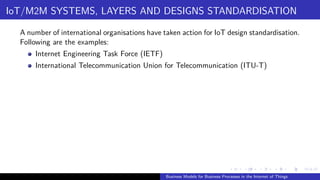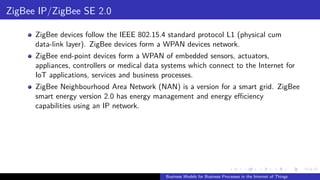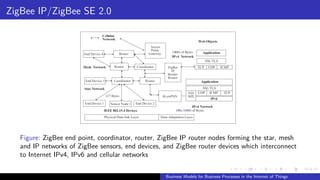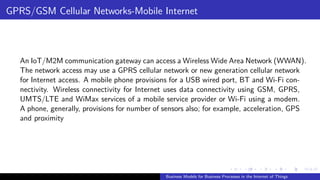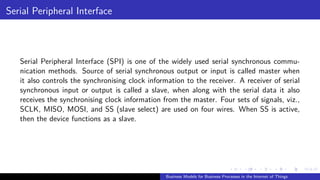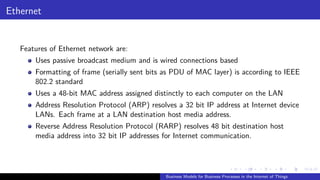communication protocols internet of things
- 1. Business Models for Business Processes in the Internet of Things Business Models for Business Processes in the Internet of Things
- 2. IoT/M2M SYSTEMS, LAYERS AND DESIGNS STANDARDISATION A number of international organisations have taken action for IoT design standardisation. Following are the examples: Internet Engineering Task Force (IETF) Business Models for Business Processes in the Internet of Things
- 3. IoT/M2M SYSTEMS, LAYERS AND DESIGNS STANDARDISATION A number of international organisations have taken action for IoT design standardisation. Following are the examples: Internet Engineering Task Force (IETF) International Telecommunication Union for Telecommunication (ITU-T) Business Models for Business Processes in the Internet of Things
- 4. IoT/M2M SYSTEMS, LAYERS AND DESIGNS STANDARDISATION A number of international organisations have taken action for IoT design standardisation. Following are the examples: Internet Engineering Task Force (IETF) International Telecommunication Union for Telecommunication (ITU-T) European Telecommunication Standards Institute (ETSI) Business Models for Business Processes in the Internet of Things
- 5. IoT/M2M SYSTEMS, LAYERS AND DESIGNS STANDARDISATION A number of international organisations have taken action for IoT design standardisation. Following are the examples: Internet Engineering Task Force (IETF) International Telecommunication Union for Telecommunication (ITU-T) European Telecommunication Standards Institute (ETSI) Open Geospatial Consortium (OGC) Business Models for Business Processes in the Internet of Things
- 6. Internet Engineering Task Force (IETF) Internet Engineering Task Force (IETF), an international body initiated actions for ad- dressing and working on the recommendations for the engineering specifications for the Internet of Things. IETF suggests the specifications for the layers, and the engineering aspects for the IoT communication, networks and applications. Business Models for Business Processes in the Internet of Things
- 7. International Telecommunication Union for Telecommunication (ITU-T) International Telecommunication Union for Telecommunication (ITU-T) suggested a reference model for IoT domain, network and transport capabilities for the IoT services and the applications at the application and application-support layers. Business Models for Business Processes in the Internet of Things
- 8. European Telecommunication Standards Institute (ETSI) European Telecommunication Standards Institute (ETSI) initiated the development of a set of standards for the network, and devices and gateway domains for the communication between machines (M2M). ETSI proposed high-level architecture for applications and service capabilities. Business Models for Business Processes in the Internet of Things
- 9. Open Geospatial Consortium (OGC) Open Geospatial Consortium (OGC), an International Industry Consortium, has also suggested open standards for sensorsŌĆÖ discovery, capabilities, quality and other aspects with support to geographical information web support. Business Models for Business Processes in the Internet of Things
- 10. COMMUNICATION TECHNOLOGIES Physical cum data-link layer in the model consists of a local area network/personal area network. A local network of IoT or M2M device deploys one of the two types of technologiesŌĆö wireless or wired communication technologies. Wireless Communication Technology Near-Field Communication Bluetooth BR/EDR and Bluetooth Low Energy ZigBee IP/ZigBee SE 2.0 Wi-Fi GPRS/GSM Cellular Networks-Mobile Internet Wireless USB Business Models for Business Processes in the Internet of Things
- 11. COMMUNICATION TECHNOLOGIES Wired Communication Technology UART/USART Serial Communication Serial Peripheral Interface I2C Bus Wired USB Ethernet Business Models for Business Processes in the Internet of Things
- 12. Near-Field communication (NFC) Near-Field communication (NFC) is an enhancement of ISO/IEC214443 standard for contact-less proximity-card. NFC is a short distance (20 cm) wireless communication technology It enables data exchange between cards in proximity and other devices. Examples of applications of NFC are proximity-card reader/RFID/IoT/M2M/mobile device, mobile payment wallet, electronic keys for car, house, office entry keys and biometric passport readers. Business Models for Business Processes in the Internet of Things
- 13. NFC NFC devices transmit and receive data at the same instance and the setup time (time taken to start the communication) is 0.1 s. The device can also communicate with Bluetooth and Wi-Fi devices in order to extend the distance from 10 cm to 30 m or higher. The device is able to receive and pass the data to a Bluetooth connection or standardised LAN or Wi-Fi using information handover functions. Business Models for Business Processes in the Internet of Things
- 14. Bluetooth BR/EDR and Bluetooth Low Energy Bluetooth devices follow IEEE 802.15.1 standard protocol for L1 (physical cum data-link layer). BT devices form a WPAN devices network. Two types of modes for the devices are Bluetooth BR/EDR (Basic Rate 1 Mbps/Enhanced Data Rate 2 Mbps and 3 Mbps) and Bluetooth low energy (BT LE 1Mbps). A latest version is Bluetooth v4.2. BT LE is also called Bluetooth Smart. Bluetooth v4.2 (December 2014) provides the LE data packet length extension, link layer privacy and secure connections, extended scanner and filter link layer policies and IPSP. Business Models for Business Processes in the Internet of Things
- 15. Bluetooth BR/EDR and Bluetooth Low Energy BT LE range is 150 m at 10 mW power output, data transfer rate is 1 Mbps and setup time is less than 6 s. Bluetooth v5, released in June 2016, has increased the broadcast capacity by 800quadrupled the range and doubled the speed. A device may have provisions for single mode BT LE or dual mode BT BR/EDR (Mbps stands for Million Bits per second). Business Models for Business Processes in the Internet of Things
- 16. ZigBee IP/ZigBee SE 2.0 ZigBee devices follow the IEEE 802.15.4 standard protocol L1 (physical cum data-link layer). ZigBee devices form a WPAN devices network. ZigBee end-point devices form a WPAN of embedded sensors, actuators, appliances, controllers or medical data systems which connect to the Internet for IoT applications, services and business processes. ZigBee Neighbourhood Area Network (NAN) is a version for a smart grid. ZigBee smart energy version 2.0 has energy management and energy efficiency capabilities using an IP network. Business Models for Business Processes in the Internet of Things
- 17. ZigBee IP/ZigBee SE 2.0 ZigBee NAN is for devices which are used for smart-metering, distribution automation devices and smart grid communication profile. NAN enables a utilityŌĆÖs last-mile at HAN (Home Area Network), outdoor access network that connects smart meters to WAN (widearea network) gateways. figure shows ZigBee End Point, Coordinator, Router, ZigBee IP Router modes forming star, mesh and IP networks of ZigBee sensors, end devices and ZigBee router device which interconnect to Internet IPv4, IPv6 and to cellular networks Business Models for Business Processes in the Internet of Things
- 18. ZigBee IP/ZigBee SE 2.0 Figure: ZigBee end point, coordinator, router, ZigBee IP router nodes forming the star, mesh and IP networks of ZigBee sensors, end devices, and ZigBee router devices which interconnect to Internet IPv4, IPv6 and cellular networks Business Models for Business Processes in the Internet of Things
- 19. ZigBee IP/ZigBee SE 2.0 The above figure shows Three end devices, two routers, one sensor node connected to coordinator ZigBee devices forming a star network. One end device, two routers and one coordinator forming a mesh network. Mesh network router connects to an AP/gateway, which in turn connects to a cellular network. Coordinator of mesh network connects to ZigBee IP border router, which enables local ZigBee networksŌĆÖ connectivity to the Internet. Business Models for Business Processes in the Internet of Things
- 20. Wi-Fi Wi-Fi is an interface technology that uses IEEE 802.11 protocol and enables the Wireless Local Area Networks (WLANs). Wi-Fi devices connect enterprises, universities and offices through home AP/public hotspots. Wi-Fi connects distributed WLAN networks using the Internet. Automobiles, instruments, home networking, sensors, actuators, industrial device nodes, computers, tablets, mobiles, printers and many devices have Wi-Fi interface. They network using a Wi-Fi network. Wi-Fi is very popular. The issues of Wi-Fi interfaces, APs and routers are higher power consumption, interference and performance degradation. Business Models for Business Processes in the Internet of Things
- 21. GPRS/GSM Cellular Networks-Mobile Internet An IoT/M2M communication gateway can access a Wireless Wide Area Network (WWAN). The network access may use a GPRS cellular network or new generation cellular network for Internet access. A mobile phone provisions for a USB wired port, BT and Wi-Fi con- nectivity. Wireless connectivity for Internet uses data connectivity using GSM, GPRS, UMTS/LTE and WiMax services of a mobile service provider or Wi-Fi using a modem. A phone, generally, provisions for number of sensors also; for example, acceleration, GPS and proximity Business Models for Business Processes in the Internet of Things
- 22. Wireless USB Wireless USB is a wireless extension of USB 2.0 and it operates at ultra-wide band (UWB) 5.1 GHz to 10.6 GHz frequencies. It is for short-range personal area network (high speed 480 Mbps 3 m or 110 Mbps 10 m channel). FCC recommends a host wire adapter (HWA) and a device wire adapter (DWA), which provides wireless USB solution. Wireless USB also supports dual-role devices (DRDs). A device can be a USB device as well as limited capability host. Business Models for Business Processes in the Internet of Things
- 23. UART/USART Serial Communication A Universal Asynchronous Transmitter (UART) enables serial communication (transmis- sion) of 8 bits serially with a start bit at the start of transmission of a byte on serial Transmitter Data (TxD) output line. Serial means present one after another at succes- sive time intervals. Business Models for Business Processes in the Internet of Things
- 24. Serial Peripheral Interface Serial Peripheral Interface (SPI) is one of the widely used serial synchronous commu- nication methods. Source of serial synchronous output or input is called master when it also controls the synchronising clock information to the receiver. A receiver of serial synchronous input or output is called a slave, when along with the serial data it also receives the synchronising clock information from the master. Four sets of signals, viz., SCLK, MISO, MOSI, and SS (slave select) are used on four wires. When SS is active, then the device functions as a slave. Business Models for Business Processes in the Internet of Things
- 25. I2C Bus A number of device integrated circuits for sensors, actuators, flash memory and touch- screens need data exchanges in a number of processes. ICs mutually network through a common synchronous serial bus, called inter-integrated circuit (I2C). Four potential modes of operation (viz. master transmit, master receive, slave transmit and slave re- ceive) for I2C bus device and generally most devices have a single role and use two modes only. Business Models for Business Processes in the Internet of Things
- 26. Wired USB Universal Serial Bus (USB) is for fast serial transmission and reception between the hosts, the embedded system and distributed serial devices; for example, like connecting a keyboard, printer or scanner. USB is a bus between the host system and a number of interconnected peripheral devices. Maximum 127 devices can connect with a host. USB standard provides a fast (up to 12 Mbps) as well as a low-speed (up to 1.5 Mbps) serial transmission and reception between the host and serial devices. Both the host and device can function in a system. USB three standards are USB 1.1 (1.5 and 12 Mbps), 2.0 (mini size connector) 480 Mbps, 3.0 (micro size connector) 5 Gbps and 3.1 (super speed 10 Gbps). Business Models for Business Processes in the Internet of Things
- 27. Ethernet Ethernet standard is IEEE 802.2 (ISO 8802.2) protocol for local area network of comput- ers, workstations and device LANs. Each frame at a LAN consists of header. Ethernet enables the services of local device nodes, computers, systems and local resources, such as printers, hard disk space, software and data. Business Models for Business Processes in the Internet of Things
- 28. Ethernet Features of Ethernet network are: Uses passive broadcast medium and is wired connections based Formatting of frame (serially sent bits as PDU of MAC layer) is according to IEEE 802.2 standard Uses a 48-bit MAC address assigned distinctly to each computer on the LAN Address Resolution Protocol (ARP) resolves a 32 bit IP address at Internet device LANs. Each frame at a LAN destination host media address. Reverse Address Resolution Protocol (RARP) resolves 48 bit destination host media address into 32 bit IP addresses for Internet communication. Business Models for Business Processes in the Internet of Things
- 29. Ethernet Uses wired bus topology, and transmission speeds are 10 Mbps, 100 Mbps (unshielded and shielded wires), 1 Gbps (high-quality coaxial cable), 4 Gbps (in twisted pair wiring mode) and 10 Gbps (fiber-optic cables). Business Models for Business Processes in the Internet of Things


